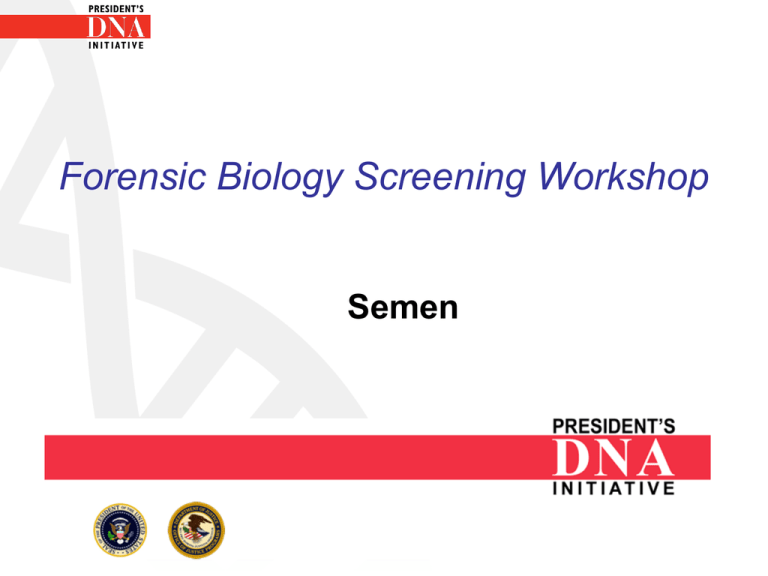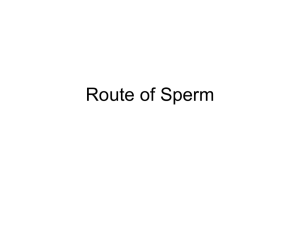
Forensic Biology Screening Workshop
Semen
Semen Composition
• Semen is a fluid of complex composition,
produced by the male sex organs.
• There is a cellular component, spermatozoa,
and a fluid component, seminal plasma.
Seminal Plasma
• Composed of salts, sugars, lipids, enzymes (such as
Acid Phosphatase), nutrients, proteins, hormones, basic
amines (spermine), P30 (Prostate Specific Antigen),
flavins (source of fluorescence under UV light)
• The components originate from several sources,
including seminal vesicles and the prostate gland
– The prostate is the source of the enzyme acid
phosphatase and the protein Prostate Specific
Antigen (PSA), or p30 protein
Seminal Plasma
Function
– Lubricates sperm duct / urethra
– Nutritive and protective liquid medium for
sperm to travel in
– Alkaline environment which protects the
sperm against the acidic nature of the vaginal
tract
Seminal Plasma
Vasectomy severs or ligates the ducts carrying
sperm to the penis
– Vasectomized men will have no sperm but will
have the plasma components present in their
ejaculate
Sperm Cells
• Sperm are the male reproductive cells
• Each consists of a head, tail and mid-piece
– In humans, the head is a tiny disc, about 4.5
µm long and 2.5 µm wide
– The tail is about 40 µm long, and is rapidly
lost in ejaculates
Sperm Cells
–The head is where the DNA is preserved
–Ape sperm are similar in size and shape
–Dogs have similarly shaped sperm but are about
three times larger than human sperm
–Other animals have differently shaped sperm
Sperm Cells
• Develop in the seminiferous tubules
– Spermatogenesis has three phases:
• Spermatocytogenesis - mitotic division
• Meiosis - diploid number present in first phase
becomes haploid
• Spermiogenesis – spherical sperm become
elongated, acrosome forms and they are released
from the seminferous tubules
Sperm Cells
• Move to the epididymis
• Upon physical stimulation:
– Sperm and seminal fluid combine in vas
deferens to form semen
• Ejaculate ~ 3-4 ml of semen
• ~70-150 million sperm per ejaculate
Male Reproductive System
Effect On Spermatogensis
•
•
•
•
•
•
•
Genetic abnormalities
Disease
Injury
Chemicals – chemotherapeutic agents
Drugs
Alcohol
Age
Sperm Cell Morphology
Composed of a head, midpiece and tail
• Head
– Acrosome cap – aids sperm entry to egg
– Houses nuclear material (DNA)
– ~4.5 µm long and 2.5 µm wide
Sperm Cell Morphology
• Midpiece
– Houses mitochondria – energy for sperm cell
• Tail
– Used for mobility, made of protein
– Long and fragile – first part to breakdown and
easily detached
– ~40 µm long
Analysis of Semen
• Semen stains fluorescence under ultraviolet light
– It is common practice to visually assess items
of evidence under UV light to locate possible
semen stains
– The intensity of the fluorescence can be
affected by the substrate, concentration of the
stain, and other body fluids
Analysis of Semen
Presumptive Tests
• Acid Phosphatase Detection
– Human semen contains high concentrations
of acid phosphatase (AP), which can
therefore be the basis of a screening test.
– While AP is detected in high concentrations in
semen, it can also be detected in other body
fluids
Analysis of Semen
Confirmatory Tests
• P30 Identification
– Found in semen
• Microscopy
– Identification of sperm cells, usually done
using a staining method
Analysis of Semen
• Acid Phosphates degrades at a much faster rate
than sperm cells
• While presumptive tests for acid
phosphatase can be helpful; a negative
result does not necessarily mean semen is
not present
• Many laboratories conduct microscopic
examinations on items that have negative
AP test results—based on the
circumstances of the case and evaluation
of the item
Survival Times
• Dried Stain
– Sperm, Acid Phosphatase, Prostate Specific Antigen
P30 – years if proper storage
• Vagina / Cervix
– Sperm, Acid Phosphatase = ~3 days (sperm possibly
longer)
– Prostate Specific Antigen P30 = ~ 1 day
• Mouth
– Sperm ~ 6 hours
– Acid Phosphatase / Prostate Specific Antigen P30 –
less due to water solubility
• Anal cavity
– Sperm ~ 9-20 hours
– Acid Phosphatase / Prostate Specific Antigen P30 less
Survival Times
Why do sperm survive longer?
• Sperm heads, very strong
• Designed to last to penetrate egg
• Proteins are water soluble, breakdown quicker
• Sperm tails are lost first
– Tails are fragile and break off
– Made of proteins, bacteria attack first
Time Lapsed Sex Kit #1 Results Table
Time
Acid Phosphatase
Microscopic Exam
0 hour
+ immediate
Many sperm, easy to find, 5-10 per
field, intact sperm found
1 hour
+ 6 seconds
Many sperm, easy to find, 3-8 per
field, intact sperm found
3 hours
+ 6 seconds
Many, easy to find, 1-3 in most
fields, intact sperm found
8 hours
+ 11 seconds
1-3 in some fields, sperm w/
broken tails, 1 intact sperm
12 hours
+ 14 seconds
7 sperm on slide, none intact
24 hours
+ 30 seconds
2 sperm on slide, none intact
37 hours
- Reaction at 56 seconds
Negative
48 hours
- No reaction at 1 minute
Negative
72 hours
- No reaction at 1 minute
Negative
Time Lapsed Sex Kit #2 Results Table
Time
Microscopic Exam
0 hour
4+ Many sperm, intact
2 hours
1 or more in most fields, intact sperm present
12 hours
Hard to find, none intact
24 hours
Hard to find, none intact
48 hours
1 possible sperm on slide
Time Lapsed Sex Kit #3 Results Table
Time
Acid Phosphatase
0 hour
+ immediate < 5 seconds
1 hour
+ 8 seconds
3 hours
+ 9 seconds
8 hours
+ 8 seconds
12 hours
+ 25 seconds
24 hours
+ 30 seconds
36 hours
+ 30 seconds
48 hours
- > 30 seconds
72 hours
- No reaction at 1 minute
Microscopic Exam
Neg for sperm, epi cells present
Acid Phosphatase
Acid Phosphatase
• Secreted from the prostate
• Cleaves phosphate group from molecules
phosphoryl choline choline
– Choline is important in cellular membrane
composition and repair
Acid Phosphatase -BCIP Test
HOW TO MAKE:
•0.5 mg 5-bromo-4-chloro-3-indolyl phosphate
(BCIP)/ml 0.01M acetate buffer, pH 5.5
Note: Dissolve the BCIP in a few drops of
dimethyl sulfoxide before bringing the solution
to volume with acetate buffer
HOW TO STORE:
•The BCIP solution is stable for at least four weeks
when stored at 4C
Acid Phosphatase -BCIP Test
HOW TO PERFORM:
•Swab question stain with a slightly moistened swab
•Place swab into tube with 200 µl BCIP substrate solution
Note: Use a known semen stain as a positive control and
an unstained swab as a negative control
•Incubate at 37° for 15 minutes
Acid Phosphatase hydrolyzes BCIP and creates a blue
color--Any blue color change is a POSITIVE result for
phosphatase activity
Acid Phosphatase –AP Spot Test
Reaction:
– Acid Phosphatase cleaves the phosphate
from α-napthyl phosphate to form napthol
– Napthol and Brentamine Fast Blue B forms a
purple azo dye
Acid Phosphatase – AP Spot Test
HOW TO MAKE:
• Buffer
–Glacial acetic acid 5 ml
–Sodium acetate, anhydrous (0.24M) 10 g
–Distilled Water 500 ml
• Solution A
–Buffer 250 ml
–Sodium a-naphthyl phosphate, 0.25% (w/v) 0.63 g
• Solution B
–Buffer 250 ml
–Naphthanil diazo blue B, 0.5% (w/v) 1.25 g (Fast Blue B)
Note: Both solutions can be combined for working solution in spot
test or used separately
Acid Phosphatase – AP Spot Test
HOW TO STORE:
•If purchased from a commercial supplier, follow
product insert regarding storage requirements
•Solution A and Solution B can be stored frozen for
months
•Solution B should be stored in an amber bottle
Note: when solution A and B are combined, the
reagent is not as stable as when stored separately
Acid Phosphatase – AP Spot Test
HOW TO PERFORM:
•Take a small cutting of the question sample and place on
filter paper/absorbent pad or swab the questioned evidence
stain
Note: Use a known semen stain as a positive control and
an unstained swab or filter paper as a negative control
•Add 1 drop of AP Spot Test reagent if both solutions
combined or 1 drop each solution; A followed by B.
•POSITIVE if purple color within 1 min.
•NEGATIVE if no color change, pink color change or color
change after 1 min.
Acid Phosphatase
False Positives
– Vaginal Acid Phosphatase
– Fecal Material
– Plant matter
– Spermicides
– Some feminine hygiene products
2 Step Acid Phosphatase Video
1 Step Acid Phosphatase Video
Acid Phosphatase (AP) Mapping
Used on large items of evidence to screen for AP
activity
HOW TO MAKE:
•Follow previous formulation, place solution A and
B into separate spray bottles
AP Mapping
HOW TO PERFORM:
• Lay out item to be mapped onto clean surface
• Staple (or otherwise attach) the appropriate size of filter
paper to a piece of plastic sheeting
• Spray the paper with DI water until damp. Lay flat onto
item marking the position/orientation. Plastic sheeting
should be on top.
• Press for ten minutes (fifteen minutes if blood is mixed
with semen). Use of a flat board or sheet of glass on top
of sheeting can aid in this process
AP Mapping
HOW TO PERFORM:
• After pressing, hang paper still attached to
plastic sheeting in a fume hood.
• Evenly spray the paper with Solution A
• Evenly spray with Solution B
• Let develop for ten minutes.
AP Mapping
HOW TO PERFORM:
• Positive stained areas appear purple. Positive stains
should appear within three minutes. Weaker stains may
take longer to appear (10-15 minutes).
Note: Use a known semen stain as a positive control;
color reaction should occur within one minute
• DO NOT overlay paper on item and mark orientation—
this should have been done in first steps
AP General Swabbing
Used on large items of evidence to screen for AP
activity
•Use a slightly moistened swab to test zones or
sections of a large item
– Follow the AP spot test or BCIP procedure
– The technique allow the analyst to screen
large items quickly
Prostate Specific Antigen (PSA) P30
Prostate Specific Antigen (P30)
– Antigen made in the prostate gland
– Weighs 30,000 kD
– Liquefies semen and is instrumental in
dissolving the cervical mucous cap for sperm
entry
Prostate Specific Antigen (PSA) P30
• Early detection was based on electrophoretic or
double diffusion Ouchterlony methods
• The methods relied on the formation of visible
precipitation of the sample and anti-p30;
oftentimes followed by staining with Coomassie
Blue.
P30 Electrophoresis
Methods
•The most widely used methods were crossover
electrophoresis and rocket immunoelectrophoresis
– Crossover: anit-p30 is placed into a well of an
agar gel opposite of the sample and allowed
to electrophoreses
• The antigens and antibodies move toward
each other and a precipitant formed
P30 Electrophoresis
Methods
• Rocket immunoelectrophoresis
– a technique in which samples are placed in a
row of wells in an agar plate containing
antiserum (anti-P30) and an electric field
perpendicular to the line of wells is applied;
this drives the antigen through the gel,
forming a spike or "rocket" precipitin pattern
trailing away from each well. The length of the
rocket is proportional to the amount of antigen
placed in the well and is semi-quantitative
Elisa Test For Semen
ELISA was another method introduced to aid in semen
identification
•Enzyme-linked immunosorbent assay (ELISA) crossover
ELISA typically involves a two-stage incubated immuno
reaction. First the target antigen binds with a solid
phase antibody. Non-bound materials are washed
away and an enzyme-labeled antibody, called a
conjugate, binds to form a 'sandwich' complex. Finally
the antigen-antibody is introduced to a substrate where
a chromogen is used to give a color change indicating
the presence of the antibody
–Shown to be a very sensitive method
Commercial P30 Tests
Ouchterlony, electrophoresis and ELISA methods
are labor intensive--this lead to the development of
faster methods
• ABAcard® P30
• Seratec® PSA Semiquant
–Semi-quantitative
– Slight differences between the two methods
ABAcard® p30
ABAcard® p30
Reaction:
– “S” area – mobile monoclonal antihuman
Prostate Specific Antigen P30 antibodies
– Prostate Specific Antigen P30 antibodies bind
to Prostate Specific Antigen P30 antigens
present in sample
– Form Antibody-Antigen complex
– Travel through card towards the “T” area
– “T” area – stationary monocolonal antihuman
Prostate Specific Antigen P30 antibodies
ABAcard® p30
• Stationary antibodies in the “T” area catch the
mobile Antigen-Antibody complex
• Forms Antigen-Antibody -Antibody complex
• Antibodies labeled with a pink dye
• When antibodies aggregate – form a pink line in
the “T” area
P30 Video
Seratec® PSA Semiquant
Seratec® PSA Semiquant
• “C” area – internal control ensures the test card
works properly.
• Binds excess mobile antihuman prostate
specific antigen P30 antibody
• Middle line is a semi-quantitative tool (Seratec®
PSA Semiquant only)
– Aids in detecting semen concentration
– If “T” line = middle line ~ 4ng/ml
– More intense = higher concentration
– Less intense = less concentration
Seratec® PSA Semiquant
High Dose Hook Effect
• Each method has noted a High Dose Hook
Effect
– Occurs with excess prostate specific antigen
P30 (high concentration of semen) which
binds to the stationary antihuman Antibody in
the “T” area
– This prevents the mobile Antibody-Antigen
complex from binding
– Results in no pink line = FALSE NEGATIVE
– Can be overcome by diluting the sample and
reanalysis
High Dose Hook Effect
ABAcard® p30 TEST
HOW TO MAKE:
•PBS (phosphate buffered saline) pH 7.4
•ABAcard ® P30 kit
HOW TO STORE:
•Follow product inserts for proper storage. PBS
can be purchased. If made in house, follow
laboratory procedures
ABAcard® p30 TEST
HOW TO PERFORM:
•Place a small piece of sample material (5mm x 5mm) in a 1.5 ml
microcentrifuge tube
•Add 250 µl of 1X PBS to the tube
•Incubate at room temperature for 2 hours with gentle agitation on a
shaker
•Pipette 200 µl of extract to the sample well “S” of the test strip
Note: Some laboratories quality control check each kit with a 4
ng/ml and a 10 ng/ml dilution of a P30. It is common practice to
include a known semen standard (positive control) and a PBS
(negative control) with each run set.
ABAcard® p30
HOW TO PERFORM:
• Read results at 10 minutes:
– A positive result is indicated by the presence of one pink line in
the test area “T”, at or before the 10 minute reading
– A negative result is indicated by the absence of one pink line in
the test area. This may result from either the absence of PSA in
the sample or it may be due to “high dose hook effect”, which
may give false negatives in the presence of high concentrations
of PSA
• If a high concentration of PSA is suspected, a 1:100 dilution
of the sample may be made to and re-run to confirm the
negative result
– Results are invalid if no pink line is present in the control area
“C”. In this case the test should be repeated.
Seratec® PSA Semiquant
HOW TO MAKE:
• PBS (phosphate buffered saline) pH 7.4
• Seratec® PSA Semiquant kit
HOW TO STORE:
• Follow product inserts for proper storage. PBS
can be purchased. If made in house, follow
laboratory procedures
Seratec® PSA Semiquant
HOW TO PERFORM:
•Place a small piece of sample material (5mm x 5mm) in a 1.5 ml
microcentrifuge tube
•Add approximately 250 µl of 1X PBS to the tube
•Incubate at room temperature for 2 hours with gentle agitation on a
shaker
•Pipette 200 µl of extract to the sample well of the test strip
Note: Some laboratories quality control check each kit with a 4
ng/ml and a 10 ng/ml dilution of a P30. It is common practice to
include a known semen standard (positive control) and a PBS
(negative control) with each run set.
Seratec® PSA Semiquant
HOW TO PERFORM:
• Read result after 10 minutes incubation at room
temperature.
– There should be no remaining fluid in the sample well
at this time point
– An estimate of the amount of PSA can be done by
comparison with the internal standard after 10
minutes
• The intensities of the internal standard and the
result may change after 10 minutes resulting in
incorrect readings
Seratec® PSA Semiquant
HOW TO PERFORM:
• Negative result (no PSA or PSA concentration
below detection limit)
– Test result line (T) is not detectable.
Appearance of internal standard line and
control line (C) confirm validity of the test
– If a high concentration of PSA is suspected, a
1:100 dilution of the sample may be made to
and re-run to confirm the negative result
Seratec® PSA Semiquant
HOW TO PERFORM:
• Positive result (PSA detectable)
– Test result line (T), internal standard line, and control
line (C) appear
• Invalid result
– Internal standard line and/or control line (C) are not
detectable
– The assay should be repeated with a new test
cassette.
– Note: If the sample contains high amounts of PSA it is
possible that the color intensity the control line is only
weak
Microscopic Examination
Sperm cells
– Spermatozoa-plural
– Spermatozoon-singular
– Male reproductive cells
– Haploid – 1 copy of each homologous chromosome
– Confirmation of the presence of semen by
microscopically identifying sperm cells
• The morphology and dimensions of the human
spermatozoon are unique
Microscopic Examination
Sperm cells
• Detection is simplified by histopathological staining
– The most common stain is known as the Christmas
tree stain because of the bright colors (kernechtrot
picroindigocarmine stain (KPIC))
•It utilizes nuclear fast red that differentially stains the
DNA containing head bright crimson, and a counter
stain of picric acid - indigocarmine (PIC) that stains
the tails green-blue-gray
Microscopic Analysis Using KPIC
HOW TO MAKE:
• Solution #1:
– Dissolve 5g aluminum sulfate in 100ml of hot
water. Add 0.1g nuclear fast red dye. Cool
and filter
• Solution #2:
– Dissolve 1g of indigocarmine dye in 300ml of
saturated picric acid solution (indigocarmine
dye = 5,5-indigo-sulfonic acid, disodium salt)
Microscopic Analysis Using KPIC
HOW TO STORE:
•Solutions are relatively stable when store at 4C
•If purchased commercially, follow product insert
instructions
Microscopic Analysis Using KPIC
HOW TO PERFORM:
• Fix a smear or stain extract to the slide by gentle heating
– A small cutting can be extracted in PBS or water
(stain extract) or a smear can be made directly on the
slide using a small cutting
• Add Solution #1 (nuclear fast red) to the smear or stain
extract on the slide and allow to stand 5 minutes
• Rinse slide with water
Microscopic Analysis Using KPIC
HOW TO PERFORM:
•Add Solution #2 (indigocarmine dye) to slide and allow to
stand 3 seconds
•Rinse slide with ethanol or methanol
•Many procedures include the application of a cover slip
using mounting media—for example: Permount
•All nuclear material will stain a red or red-purple color
•Background materials will be stained blue or green
Note: A prepared semen slide should be available for
comparison purposes
Microscopic Analysis Using KPIC
•Spermatozoa will appear as differently-stained red
bodies, somewhat oval in shape with a slight pink
cast
•The acrosomal cap will be stained less intensely
red than the nuclear portion of the sperm head
•If present, the midpiece and tail sections will be
stained green or blue-green.
Microscopic Analysis Using KPIC
It is common practice to grade the abundance of
spermatozoa on the smear from 1+ to 4+ at 200x
magnification which aids in future DNA analysis
Note: Some procedures require that spermatozoa
be verified at 1000x magnification
KIND Classification
• Method of classification originally published in
1965 by S.S. Kind
• Rare = < 10 cells on slide
• 1+ = Few; difficult to locate
• 2+ = Some in some fields
• 3+ = Some in many fields; easy to locate
• 4+ = Many in most fields
• Some laboratories have made slight
modifications to this rating scale
Microscopic Analysis Using KPIC
Head of the sperm is RED
Tail is GREEN
Acrosome remains CLEAR or faintly colored
Digital Image of KPIC stained sperm cells
Microscopic Analysis Using KPIC
Yeast, bacteria, free nuclei, white blood cells, and
dog sperm are stained with this method, and in
some instances can interfere with the identification
of sperm cells
Microscopic Analysis Using KPIC
• Always look for:
–Differential staining- acrosomal cap
–Tail, if attached
–Size -larger than yeast or bacteria, but smaller
than free nuclei or dog sperm
Having prepared human semen, dog semen,
yeast and bacteria slides stained with KPIC
should be available for comparison purposes
Christmas Tree Stain Video
Yeast
image courtesy Kimball's Biology Pages (http://biology-pages.info)
Other Stains
• Hematoxylin and Eosin staining
– Hematoxylin
• Affinity for nuclear material in the presence
of a metal
• Stains nuclear material purple
– Eosin is a counterstain
• Non nuclear material stains pink
Other Stains
• Fluorescent staining
– Example: SpermPaints – fluorescent dye
mixed with monoclonal antibodies which bind
to the sperm head and tail antigens
– Clear, bright, selective
–Will not stain other tissue types
• Giemsa staining
– Nuclei stain red
Microscopes
To clean:
• Use lens paper and lens cleaner (isopropyl
alcohol solution) for ocular lenses and glass
surface (over the light source)
• Use cotton swabs for smaller objective lenses
Microscopes







